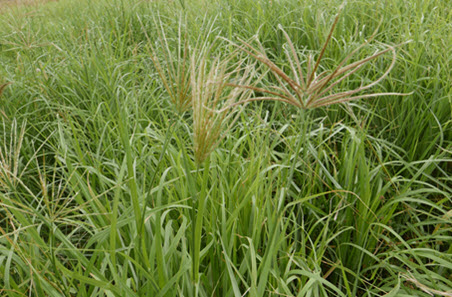Pasture dieback potential causes and management options under investigation
17 July 2018

Pasture dieback is a complex problem and MLA is investigating numerous potential causes and management options.
While the causal agent of pasture dieback is yet to be identified, the following remediation options are either showing promising results in field trials or have the potential to assist in pasture dieback management.
For more information on the treatments used in field trials, please consult the progress update which accompanies the table below or contact MLA to discuss options.
Contact:
pasturedieback@mla.com.au
|
|
Potential cause or contributing factor |
Known remediation options* |
Cost estimates ($/ha) |
Time to impact |
Remediation risks and notes |
|
1 |
Soil-borne disease caused by:
|
|
|
|
|
|
2 |
Soil-borne insects/mites |
Insecticide seed dressing Poncho™ 3
|
$4.50/kg seed (approx.)
|
Effective against certain mites and soil insects for 4–6 weeks. Refer to the label for details.
|
Poncho™ has a six week withholding period. This means stock cannot be grazed on pasture established from Poncho™ treated seed for six weeks after sowing. Always read the label and follow instructions. |
|
3 |
Mealy bugs |
Introduce biological control agents (e.g. lacewing larvae and Cryptolaemus (ladybird larvae), parasitic wasps
|
$400+/ha Individual solutions could be significantly less. |
12–24 months |
Re-release may be required. There is no trial data available on the effectiveness of predatory insects on mealy bugs on pasture. |
|
4 |
Poor soil condition/health as a contributing factor |
|
|
|
|
|
5 |
Other |
Plant-available silicon can stimulate plant disease resistance and potential control of sucking insects.7 |
$250+ application |
6 months+ |
Silicon is currently being trialled, but no results are available to date. Silicon can be detrimental to health if inhaled. Observe appropriate WHS practices. |
*These are the options under investigation and may not be the only options available. MLA welcomes feedback on these options or others not listed in the table.
Progress update
- Recent trials indicate re-sowing with pelleted pasture seed (region-specific) has established well with no sign of dieback.
- Recent trials indicate re-sowing with legume species (region-specific) has established well with no sign of dieback.
- Re-sown pasture and pasture mixes were coated with a seed dressing that included Poncho™ to protect against soil insects and mites. Cattle cannot be grazed on pasture established from Poncho™ treated seed for six weeks after sowing.
- Pasture cost estimates depend on sowing rate, application equipment and labour costs e.g. Callide Rhodes plus Lablab, 5kg Rhodes $55, 10kg Lablab $30 + $30 cultivation and sowing = $115/ha).
- Poncho™ treatment costs about $4.50/kg of seed. Re-seeding costs include Poncho™ treatment.
- Fertiliser applications were more effective when applied in combination cultivation and re-sowing. Refer to the trial update summary for fertiliser rates which have been trialled.
Note: Take precautions during application to avoid breathing in dust.
Pasture cultivation, fertiliser and re-sowing costs (based on coated seed, treated with Poncho™).
|
Pasture species |
Seed cost ($/kg) |
Seeding rate (kg/ha) |
Cost ($/ha)* |
Application cost ($/ha) |
Total cost ($/ha) |
|
Gayndah buffel |
9 |
2-10 |
18-90 |
30 |
48-120 |
|
Callide Rhodes |
11 |
2-10 |
22-110 |
30 |
52-140 |
|
Reclaimer Rhodes |
9 |
2-10 |
18-90 |
30 |
48-120 |
|
Sabi grass |
11 |
2-10 |
22-110 |
30 |
52-140 |
|
Bambatsi panic |
12 |
2-10 |
24-120 |
30 |
54-150 |
|
Floren bluegrass |
25 |
2-10 |
50-250 |
30 |
80-280 |
|
Bisset bluegrass |
25 |
2-10 |
50-250 |
30 |
80-280 |
|
Legume species |
Seed cost ($/kg) |
Seeding rate (kg/ha) |
Cost ($/ha) |
Application cost ($/ha |
Total cost ($/ha) |
|
Highworth Lablab |
3 |
20 |
60 |
30 |
90 |
|
Butterfly pea |
3 |
8 |
24 |
30 |
54 |
|
Marc Desmanthus |
25 |
3 |
75 |
30 |
105 |
* The lower cost is 2kg/ha and the upper rate is a single species is sown at 10kg/ha for coated pasture seed. This may be lower depending on pasture species, soil type and sowing mixtures.
|
Fertilisers |
($/kg) |
Rate (kg/ha) |
Cost ($/ha) |
Application cost ($/ha |
Total cost ($/ha) |
|
DAP |
1.05 |
75 |
78 |
Applied with seed |
78 |
|
DAP |
1.05 |
150 |
158 |
Applied with seed |
158 |
|
Urea |
0.8 |
100 |
80 |
Applied with seed |
80 |
|
Superphosphate |
0.8 |
100 |
80 |
Applied with seed |
80 |
|
Rock phosphate |
1.08 |
100 |
108 |
Applied with seed |
108 |
|
MAP |
1.68 |
100 |
168 |
Applied with seed |
168 |
*All fertiliser prices based on 25kg bags; cost will be reduced when buying bulk.
Disclaimer
Any recommendations, suggestions or opinions contained in this publication do not necessarily represent the policy or views of Meat & Livestock Australia (MLA) or associated research providers. No person should act on the basis of the contents of this publication without first obtaining specific, independent professional advice. MLA takes no responsibility, in any way whatsoever, to any person in respect to the document, including any errors or omissions therein, arising through negligence or otherwise however caused.


